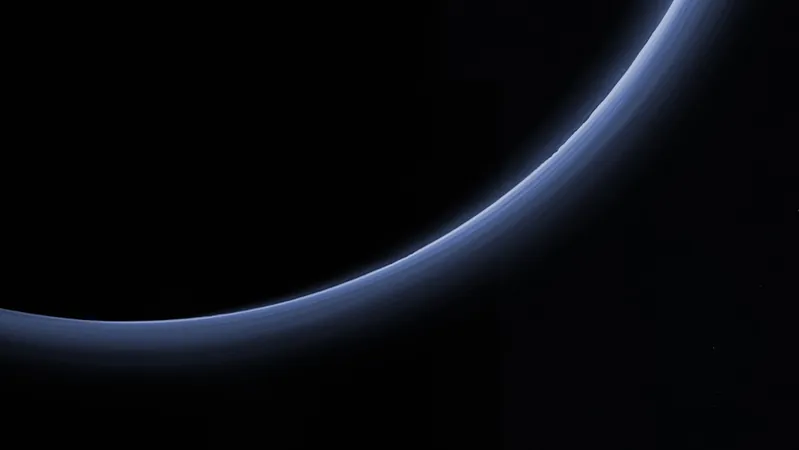
Astounding Discovery: James Webb Telescope Uncovers a Unique Climate on Pluto!
2025-06-15
Author: William
Astronomers peering through the lens of the James Webb Space Telescope (JWST) have cast a new light on the mysterious edges of our solar system, revealing that Pluto continues to astonish us with its secrets.
Initially thought to be a lifeless ball of ice, NASA's New Horizons mission in 2015 completely overturned that notion, unveiling stunning icy plains and jagged mountains. Among the most jaw-dropping findings was a bluish, multi-layered haze hovering more than 185 miles (300 kilometers) above its surface—an unexpected feature that was both elaborate and enigmatic.
Fast forward to nearly a decade later, and JWST has confirmed that this haze plays a critical role in modulating Pluto's climate, not just adorned the skies.
Tanguy Bertrand, an astronomer from the Paris Observatory leading the analysis, exclaimed, "This is unique in the solar system. It's a new kind of climate!" The insights shared in the June 2 study published in Nature Astronomy indicate that similar atmospheric phenomena might be unfolding on other haze-covered celestial bodies and could even reveal insights into Earth's early climatic history.
Unlocking the Secrets of Pluto's Haze
Pluto's high-altitude haze, enriched with organic molecules formed through sunlight-mediated reactions involving methane and nitrogen, brings a refreshing twist to our understanding of planetary atmospheres. The theory that this haze controls the dwarf planet’s climate was first suggested in 2017, postulating that during the day, these particles absorb sunlight, only to release it back into space as infrared energy at night. This mechanism might explain why Pluto's upper atmosphere cools to a bone-chilling -333 degrees Fahrenheit (-203 degrees Celsius)—an astonishing 30 degrees colder than earlier predictions.
However, confirming this hypothesis has been no cakewalk. Challenges arose due to the gravitational dance between Pluto and its large moon, Charon, which often obscured the data. Bertrand noted, "We couldn't pinpoint which signals were from Pluto and which from Charon."
The researchers predicted that Pluto’s haze would brighten its mid-infrared wavelengths, a hypothesis only testable with advanced instruments. The JWST provided that opportunity in 2022, successfully isolating the signals and confirming the earlier prediction.
Xi Zhang, a planetary scientist from the University of California, Santa Cruz and leader of the original study, expressed his excitement: "It's not common in planetary science to have a hypothesis confirmed so quickly, so we feel fortunate!"
What This Means for Us and Beyond
The implications of this research are far-reaching. Bertrand theorizes that haze-driven climates may exist not just on Pluto but also on other celestial bodies like Neptune’s moon Triton or Saturn’s moon Titan. Interestingly, the findings may even hint at Earth’s distant past—before our planet’s atmosphere became oxygen-rich, it might have been enveloped in a similar haze that stabilized temperatures and was conducive to early life.
Zhang concluded, "By studying Pluto's haze and chemistry, we might gain fresh insights into the conditions that made early Earth habitable." The revelation from JWST not only enhances our understanding of Pluto but could also reshape our perspective on the origins of life on Earth.









 Brasil (PT)
Brasil (PT)
 Canada (EN)
Canada (EN)
 Chile (ES)
Chile (ES)
 Česko (CS)
Česko (CS)
 대한민국 (KO)
대한민국 (KO)
 España (ES)
España (ES)
 France (FR)
France (FR)
 Hong Kong (EN)
Hong Kong (EN)
 Italia (IT)
Italia (IT)
 日本 (JA)
日本 (JA)
 Magyarország (HU)
Magyarország (HU)
 Norge (NO)
Norge (NO)
 Polska (PL)
Polska (PL)
 Schweiz (DE)
Schweiz (DE)
 Singapore (EN)
Singapore (EN)
 Sverige (SV)
Sverige (SV)
 Suomi (FI)
Suomi (FI)
 Türkiye (TR)
Türkiye (TR)
 الإمارات العربية المتحدة (AR)
الإمارات العربية المتحدة (AR)